by Melanie Taylor | Aug 5, 2017
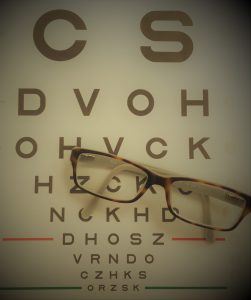
Most of us are willing to go to the doctor or the dentist, which are both part of taking care of our health. However, do you go to the eye doctor? If not, you definitely should add it to your healthy lifestyle regime. Eye exams at every age and stage of life can help you keep your vision strong. August is National Eye Exam month; this is the perfect reminder to schedule a comprehensive eye exam.
The Vision Council of America reports that 12.2 million Americans require some sort of vision correction, but do not use any. Nearly 50% of parents with children under 12 have never taken their children to an eye-care professional.
Many people think their eyesight is just fine, but then they get that first pair of glasses or contact lenses and the world becomes much clearer – everything from fine print to street signs. Improving and/or maintaining your eyesight is important – about 11 million Americans over age 12 need vision correction, but that is just one of the reasons to get your eyes examined. Regular eye exams are also an important part of finding eye diseases early and preserving your vision.
Eye diseases are common and can go unnoticed for a long time. Some diseases have no symptoms at first. A comprehensive dilated eye exam by an optometrist (a medical professional with a focus on regular vision care who can prescribe eyeglasses and contacts) or ophthalmologist (a medical eye doctor with a focus on the complete eye health) is necessary to find eye diseases in the early stages when treatment to prevent vision loss is most effective. During the exam, visual acuity (sharpness), depth perception, eye alignment, and eye movement are tested. Eye drops are used to make your pupils larger so your eye doctor can see inside your eyes and check for signs of health problems.
How often should you have an eye exam?
- A child’s eyes should be checked regularly by an eye doctor or pediatrician. The U.S. Preventive Services Task Force recommends vision screening for all children at least once between age 3 and 5 years to detect amblyopia or risk factors for the disease. Amblyopia is when the vision in one of the eyes is reduced because the eye and the brain are not working together properly. The eye itself looks normal, but it is not being used normally because the brain is favoring the other eye. This condition is sometimes called lazy eye.
- People with diabetes should have a dilated eye exam every year.
- People with a family history of glaucoma should have an eye exam every year.
- Adults with good health should have an eye exam at least every 2 years.
Some people are at higher risk for glaucoma and should have a dilated eye exam every 1 to 2 years:
- African Americans, ages 40 years and older.
- Everyone older than age 60, especially Mexican Americans.
- People with a family history of glaucoma.
Early treatment is critically important to prevent some common eye diseases from causing permanent vision loss or blindness:
- Cataracts (clouding of the lens), the leading cause of vision loss in the United States.
- Diabetic retinopathy (causes damage to blood vessels in the back of the eye), the leading cause of blindness in American adults.
- Glaucoma (a group of diseases that damages the optic nerve).
- Age-related macular degeneration (gradual breakdown of light-sensitive tissue in the eye).
Other reasons to see your eye doctor: If you have any of the following eye problems, do not wait for your next appointment, schedule your eye appointment as soon as possible:
- Decreased vision
- Draining or redness of the eye
- Eye pain
- Double vision
- Diabetes
- Floaters (tiny specks that appear to float before your eyes)
- Halos around lights
- Flashes of light.
Center for Disease Control and Prevention (CDC) 10 Tips to Protect Your Vision:
- Get a regular comprehensive dilated eye exam.
- Know your family’s eye health history.
- Eat right to protect your sight. You have heard that carrots are good for your eyes. But eating a diet rich in fruits and vegetables—particularly dark leafy greens, such as spinach, kale, or collard greens—is important for keeping your eyes healthy, too.
- Maintain a healthy weight.
- Wear protective eyewear when playing sports or doing activities around the home. Protective eyewear includes safety glasses and goggles, safety shields, and eye guards specially designed to provide the correct protection.
- Be cool and wear your shades. Wear sunglasses that block out 99% to 100% of UV-A and UV-B radiation (the sun’s rays).
- Give your eyes a rest. If you spend a lot of time at the computer or focusing on any one thing, you sometimes forget to blink and your eyes can get fatigued. Try the 20-20-20 rule: Every 20 minutes, look away about 20 feet in front of you for 20 seconds. This short exercise can help reduce eyestrain.
- Clean your hands and your contact lenses properly.
- Practice workplace eye safety.
- Quit smoking or never start.
Of the estimated 61 million US adults at high risk for vision loss, only half visited an eye doctor last year. Regular eye care can have a life-changing impact on preserving the vision of millions of people. Be sure to make your eye health a priority in your life. Healthy eyes lead to better vision and an overall better quality of life. Sources: Vision Council of America https://www.thevisioncouncil.org/ Center for Disease Control and Prevention https://www.cdc.gov/
by Samantha Kennedy | Aug 5, 2017
 Oh, watermelon. How do I love thee? Let me count the ways.
Oh, watermelon. How do I love thee? Let me count the ways.
Watermelon is the perfect warm weather treat and a summer holiday essential. It’s a sweet, light, and delicious snack and its versatility lends itself to a wide variety of beverages, salads, meals, and desserts.
Watermelon is more than just water and sugar. It’s jam-packed with a number of vitamins and minerals that can help you stay healthy, including vitamin A, vitamin B6, vitamin C, potassium, and lycopene.
Vitamin A is vital to eye health and helps boost your immune system by supporting the functions of the infection-fighting white blood cells.
Vitamin B6 has many functions in the body, including aiding in immunity by supporting the creation of antibodies, which are needed to fight off infection. It also helps maintain proper nerve function and aids in the creation of red blood cells, which carry oxygen to all parts of the body. Vitamin B6 is also used to break down proteins into smaller parts that can be used to build and maintain muscle mass.
Vitamin C also helps boost immunity and overall cell health by helping to break down free radicals in the body, which can deteriorate cells over time.
Potassium is a mineral that is necessary for keeping a healthy water balance in the body, helping to maintain proper water balance and reducing the incidence of painful muscle cramps.
Lycopene is one of a family of vitamin precursors known as carotenoids. This substance is what helps give those bright red and pink fruits and vegetables – such as watermelon – their lovely color. Lycopene and other carotenoids function as antioxidants, which help eliminate those previously mentioned harmful free radicals. And preliminary studies have shown that lycopene may help reduce triglycerides and LDL cholesterol, which may lead to a reduction in cardiovascular disease risk.
Nearly every part of the watermelon can be eaten, from the sweet and juicy fruit to the rind, which is often pickled or used in stir frys. Even the fruit itself can be grilled and served as part of a savory dish. And watermelon is a sweet addition to many colorful summer salads.
One of my favorite watermelon recipes is a twist on a traditional favorite – Watermelon Lemonade – and is sure to be a great addition to any of your summertime picnics. Try it today!
Watermelon Lemonade
Ingredients
1/2 cup lemon juice
2 1/2 cups water
2/3 cups agave syrup*
2 cups watermelon chunks
*Other sweeteners may be used instead of agave syrup. However, be careful when adding them, as you may need to use less. Add to taste, mixing in a little at a time until you reach the desired sweetness.
Instructions
Place all the ingredients in a blender and blend until smooth. Serve over ice.
Servings
Makes about 5 cups.
Nutrition Facts
Serving size: 1 cup
Calories per serving: 163
Fat per serving: 0.3g
Saturated fat per serving: 0.0g
Fiber per serving: 0.3g
For more delicious recipes, please visit http://www.watermelon.org/Recipes.

by Ginny Hinton | Jun 30, 2017
 Driving to work this morning, I had to swerve to miss a driver who had crossed the center line. Thankfully, I was paying attention and he got back in his lane fairly quickly, so no one was hurt. I suspect the other driver never realized that he almost had a close encounter of the dangerous kind.
Driving to work this morning, I had to swerve to miss a driver who had crossed the center line. Thankfully, I was paying attention and he got back in his lane fairly quickly, so no one was hurt. I suspect the other driver never realized that he almost had a close encounter of the dangerous kind.
We’ve all heard the warning: driving while texting can be a deadly distraction. The problem is that most of us live fairly hectic lives. We may not intend to talk or text while we drive but the temptation to multi-task can be overwhelming – especially when we’re under a deadline. And honestly? Most of us think our driving skills are a shade above average and we can cope with a little distraction.
The hard truth is that cell phone use, especially texting, is “associated with the highest levels of driving performance degradation.” Even the most experienced texting driver takes twice as long to react, making texting a seriously dangerous activity. Around 69% of drivers, ages 18-64, report having used their phones while driving over the past 30 days. With over 9 people killed and 1,060 injured every day due to distracted driving, that’s a major problem.
So, what makes texting and driving so dangerous? You may have heard that the average texting driver takes his or her eyes off the road for an average of 5 seconds. At 55 mph, that’s like traveling the length of a football field blindfolded. What you may not know is that there are three distinct forms of driving distraction:
- Visual (requires driver to look away from the road)
- Manual (requires driver to take a hand or hands off the wheel to manipulate an object)
- Cognitive (thinking about something other than driving)3
According to the National Highway Traffic Safety Administration, texting is among the worst of driver distractions because it involves all three forms at the same time. With over 320 million cell phone subscriptions in the US today, it’s a problem that continues to grow.
Only you can make the decision to be an alert driver. Choosing to focus on your driving makes you better – and safer – while sharing the road.
Sources:
- Vegega, M., Jones, B., & Monk, C. (2013, December). Understanding the effects of distracted driving and developing strategies to reduce resulting deaths and injuries: A report to Congress (Report No. DOT HS 812 053). Washington, DC: National Highway Traffic Safety Administration.
- Cooper, J., Yager, C., Chrysler, S., (2011, August). An Investigation of the Effects of Reading and Writing Text-based Messages While Driving. Southwest Region University Transportation Center: Texas Transportation Institute.
- What Is Distracted Driving?, 2017, National Highway Traffic Safety Administration. http://nhtsa.gov/risky-driving/distracted-driving#34621.
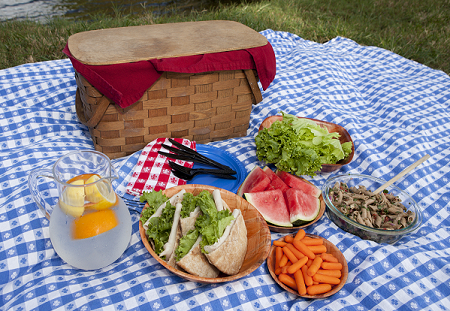
by Samantha Kennedy | Jun 27, 2017
 There are few things more iconic during summer than a picnic. There’s just something fresh and fun about sharing a meal in the park or at the beach with family and friends. But just because you’re enjoying the warm, gentle breeze doesn’t mean you should throw caution to the wind. By following a few simple food safety tips, you can ensure that your perfectly planned picnic doesn’t make you sick.
There are few things more iconic during summer than a picnic. There’s just something fresh and fun about sharing a meal in the park or at the beach with family and friends. But just because you’re enjoying the warm, gentle breeze doesn’t mean you should throw caution to the wind. By following a few simple food safety tips, you can ensure that your perfectly planned picnic doesn’t make you sick.
Planning it out. Not all foods are picnic-appropriate. Anything that requires a lot of perishable ingredients and/or a lot of preparation should be avoided. Stick with foods that require little or no cooking and that contain just a few ingredients. Foods such as fruits and vegetables (especially whole ones), hard cheeses, peanut butter and jelly, cereal, bread, and crackers are ideal picnic items. Anything made with commercially processed custard or mayonnaise will stay safe as long as they are kept cold.
Packing it up. Use a cooler, if possible, and store cold foods together so they can help each other stay colder longer. Use ice or frozen gel packs to help keep foods cold. Pack foods directly from the refrigerator into the cooler; don’t leave them sitting out before packing. Store ready-to-eat foods separately from raw meats. If packing up hot foods, be sure to keep them in a thermos or other insulated dish. DO NOT store them in the same container as the cold foods. Paper towels, disposable utensils, and a food thermometer are ideal picnic accessories. Remember, keep cold foods below 41 degrees F and hot foods above 135 degrees F. Do your best to keep the cooler away from direct sunlight by storing it in the shade and be sure to replenish the ice and/or frozen gel packs when they melt. Consider packing drinks in a separate cooler, as they are consumed more frequently; this will reduce the exposure of food items to warm air until you’re ready to eat.
Preparing the feast. All food items should be kept at the proper temperature at all times. When cooking raw meats, use separate plates for the raw and cooked products and clean and sanitize utensils between uses. Cook meat to the proper recommended internal temperature to ensure doneness and safety. Click here for a list of recommended internal cooking temperatures.
Presenting the bounty. Discard any perishable foods that have been left out for longer than two hours. In really hot weather (generally above 90 degrees F), foods should not be left out longer than one hour. Keep food protected in storage containers such as coolers and lidded dishes to minimize contamination from flies and other pests. Serve small portions of food at a time and keep the rest in the cooler.
Picnics are an important part of summer and with just a little bit of planning and a few useful tips and tools, they can be safe and delicious for everyone!
Source: Beaugh, Kristina. “Checklist for the Perfect Summer Picnic,” Foodsafety.gov blog, June 16, 2015. URL: https://www.foodsafety.gov/blog/2015/06/picnic.html.
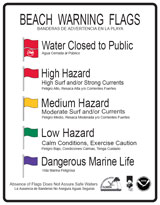
by Marie Arick | Jun 27, 2017
Summer is upon us and that means many of us will be enjoying pools, lakes, rivers, and the ocean. Florida provides many opportunities for outdoor water recreation that we should enjoy responsibly and safely. Are you prepared to handle a water emergency? Do you have water safety rules? Do you know CPR? These are all things to consider. Not everyone is ‘waterproof’ and taking precautions can really prevent a misfortune.
As the warm summer months draw many of us to the water for fun and fellowship, remember, sudden things are sudden and people drown quickly and quietly. Being honest about your swimming abilities is important. If you are not a strong swimmer, chances are you will not be able to help someone in trouble. This is also important if you are supervising others. Take the time to work on your swimming skills with others or take lessons. Knowing basic cardiopulmonary resuscitation, CPR, also can increase the chances of survival for a drowning victim.
There is safety in numbers; enlist another adult to help when supervising swimming children. If you are at a public beach, river, or lake, locate the lifeguard and position yourself close to the stand. If the beach is the locale for the day, look for the flag to alert you to the surf conditions and adhere to the recommendations of the flag and signage. If you are at a venue with no lifeguard on duty, you are now the lifeguard! Locate any emergency devices available to you and be certain you have cell phone reception in case you must call for help. Have those you are supervising demonstrate their swimming abilities. Knowledge of someone’s swimming abilities in advance can allow you to set safer boundaries. For example, if a child cannot swim the width of the pool without stopping and placing their feet on the bottom, you have determined, for their safety, they must remain in the shallow area of the pool where they can stand up. Another great option is to have the children utilize swimming vests. Never allow for rough play in the water. What seems to be harmless quickly can become life- threatening.
No matter the venue, ocean, river, lake, or pool, be steadfast in monitoring the swimmers and prepared to assist if you are needed. The American Red Cross and National Swimming Pool Foundation have an online course to educate pool owners. The American Heart Association provides the option of taking an online CPR course. Being prepared for a potential crisis is the first step to avoiding a crisis. Many wishes for a safe summer of water fun!
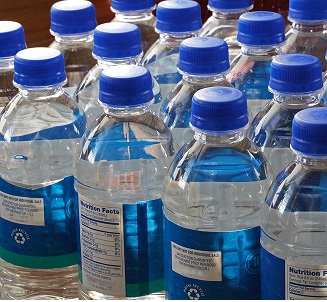
by Dorothy C. Lee | Jun 27, 2017
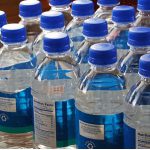
Carry water with you to sip throughout the day
Summer has arrived! During the summer months, especially along the Gulf Coast, it is hot and humid. Keeping the body hydrated is important to maintaining good health.
As the temperature rises in the summer and the body loses more water through evaporation and perspiration, it makes good sense to increase your intake of fluids. Keep in mind that by the time you notice you are thirsty, you have already depleted your water stores dramatically. A good rule of thumb is to drink a few ounces of water every fifteen to thirty minutes when you are working or playing hard in the heat.
- Myth or Fact – You should drink at least eight glasses of water a day.
Myth – On average, the body requires a half gallon of water daily. That’s the amount required to replace what has been lost through perspiration, evaporation, and body waste. Milk, juice, and other fluids can be added to your daily total. Beverages that contain caffeine, such as coffee, tea, and soft drinks, are not good substitutes for water. Caffeine actually may cause the body to lose water. The same is true for alcoholic beverages. They contribute to water loss, not gain, because alcohol acts as a diuretic.
- Myth or Fact – All water is the same.
Myth – The following guide will help you navigate the sea of choices available:
- Distilled Water – is pure water with no added chemicals or minerals.
- Mineral Water – is available in canned or bottled varieties. Many brands include a mix of minerals to improve the taste. Natural or artificial flavors, such as lime or lemon, may be added to some. Some varieties add sugar. Check the label.
- Soft Water– commercially softened water often is treated with salt and tends to be high in sodium.
- Sparkling Water– some sparkling waters contain bubbles naturally; others are created with the addition of carbon dioxide.
- Well Water – is more commonly known as tap water.
- Myth or Fact – Increasing daily water and fluid intake is difficult.
Myth – Actually, there are a variety of ways to increase water and other fluid intake. Purchase a insulated water bottle and refill it throughout the day. Add flavor to water. Infused water is becoming a popular food trend. Infuse with strawberries, lemons, limes, or other flavorful fruits and vegetables. Choose foods that contain high levels of water content – for example, watermelon, grapes, and kiwi. Start the day with a glass of water at breakfast.
- Myth or Fact – Water aids in bodily functions.
Fact – Water contributes about sixty percent of an adult’s body weight. Staying hydrated may be a major benefit to increasing energy production. Increased water consumption can aid in weight loss. Water aids in the body’s temperature regulation, acts as a lubricant, and cushions around joints. Water serves as a solvent for minerals, vitamins, amino acids, and glucose. Because water is vital to bodily functions, the body directs many of its activities toward maintaining balance.
- Myth or Fact – You can drink too much water.
Fact – Over-hydration can result in water intoxication. Water intoxication occurs when you consume more water than the kidneys can excrete. Consuming large amounts of water in a short period of time can result in intoxication. Remember, you should drink at least eight glasses of water a day – it’s a fact.
Reference: https://authoritynutrition.com/7-health-benefits-of-water/









